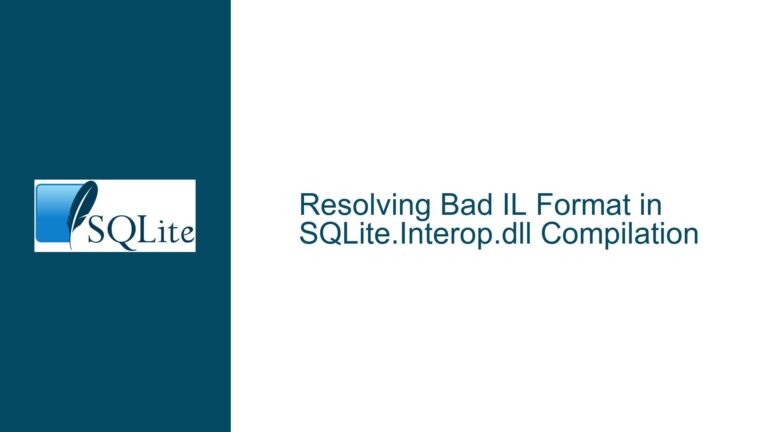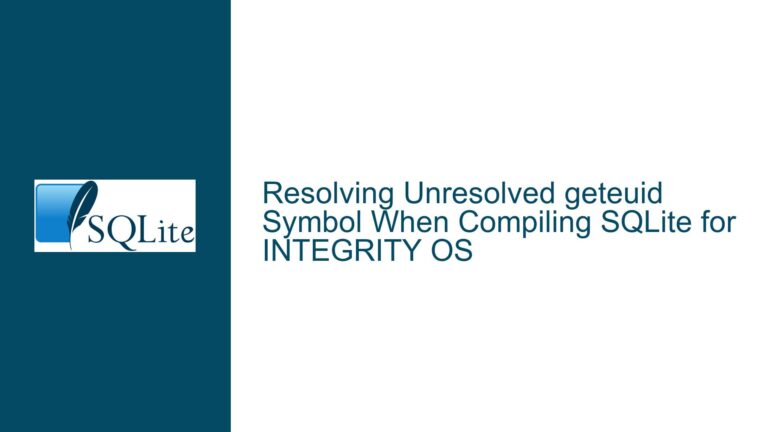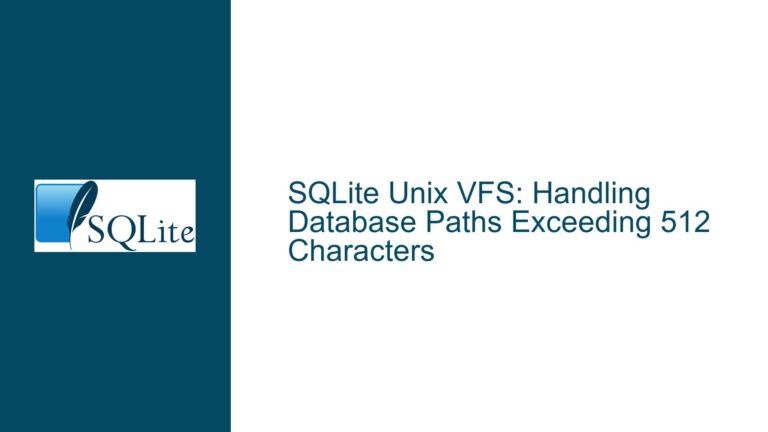Tracking Transaction Visibility Across SQLite Connections for Consistent Read-Cutoffs
Understanding Transaction Visibility and Cutoff Coordination in SQLite
The Challenge of Cross-Connection Transaction Awareness
The fundamental problem arises when an application requires deterministic coordination between read and write operations across multiple SQLite connections. Consider a scenario where:
- Read Transaction T1 executes a filtered count query at time X
- Write Transactions W1, W2, W3 modify data concurrently
- Subsequent Read Operations must determine if they incorporate results from specific writes
SQLite’s snapshot isolation guarantees that a read transaction sees a consistent database state frozen at transaction start. However, there’s no built-in mechanism to:
- Compare transaction temporal relationships across connections
- Determine whether specific writes occurred before/after a read’s snapshot
- Create universal sequence numbers for writes visible to all connections
This creates synchronization challenges for applications needing to:
- Validate if UI events correspond to pre-count or post-count data states
- Implement "read cutoff" markers for incremental data loading
- Coordinate cache invalidation across distributed components
Key constraints include:
- No native transaction IDs or commit timestamps
- WAL mode’s multi-version concurrency control (MVCC) hiding write sequencing
- Rowid/autoincrement values being insufficient due to update operations
Core Limitations in Native SQLite Functionality
1. Absence of Transaction Metadata Exposure
SQLite deliberately omits transaction identifiers to maintain its lightweight architecture. The WAL file tracks transaction changes internally through frame counters and checksums, but these details are:
- Connection-specific
- Not exposed through public APIs
- Subject to format changes between versions
2. Data_Version Pragma Limitations
While PRAGMA data_version provides a database-wide change counter, it:
- Increments on any schema/data modification
- Lacks granularity for individual transactions
- Can’t correlate writes across connections
- Resets on database closure/reopen
3. Temporal Ambiguity in Write Ordering
Timestamps (via STRFTIME or OS time) fail because:
- Write transactions may commit out of chronological order
- System clock skews across processes/machines
- Transaction duration overlaps create ambiguous time windows
4. Rowid/Autoincrement Gaps
Using MAX(rowid) as a write marker doesn’t account for:
- Updates to existing rows changing filter matches
- Deleted rows creating sequence gaps
- Virtual tables without rowid columns
Implementing a Cross-Connection Transaction Sequence System
Step 1: Transaction Sequence Table Schema Design
Create a dedicated table to track write sequencing:
CREATE TABLE transaction_sequence (
singleton INTEGER PRIMARY KEY CHECK (singleton = 1),
seq INTEGER NOT NULL
);
INSERT INTO transaction_sequence VALUES (1, 0);
This single-row table ensures:
- Atomic updates through row-level locking
- Sequential integer progression without gaps
- Cross-connection visibility through standard MVCC
Step 2: Write Transaction Instrumentation
Modify all write operations to increment the sequence counter. For manual writes:
BEGIN IMMEDIATE;
-- Application data modifications
UPDATE transaction_sequence SET seq = seq + 1;
COMMIT;
For automated instrumentation, create triggers on target tables:
CREATE TRIGGER increment_seq_after_insert
AFTER INSERT ON target_table
BEGIN
UPDATE transaction_sequence SET seq = seq + 1;
END;
CREATE TRIGGER increment_seq_after_update
AFTER UPDATE ON target_table
FOR EACH ROW WHEN NEW.column1 != OLD.column1 -- Optional conditional
BEGIN
UPDATE transaction_sequence SET seq = seq + 1;
END;
Step 3: Read Transaction Sequence Capture
At read transaction start:
BEGIN TRANSACTION;
SELECT seq FROM transaction_sequence;
-- Store this value as 'read_cutoff_x'
-- Execute main query (e.g., filtered count)
COMMIT;
This works because:
- The SELECT establishes the read transaction’s snapshot
- Subsequent writes increment the sequence but remain invisible
- All writes with seq > read_cutoff_x occurred after the snapshot
Step 4: Event Metadata Tagging
For UI events generated by writes:
-- During write transaction
INSERT INTO event_log (event_data, write_seq)
VALUES ('...', (SELECT seq FROM transaction_sequence));
-- Or using last_insert_rowid() if using trigger-based increments:
INSERT INTO event_log (event_data) VALUES ('...');
INSERT INTO seq_log (seq) VALUES (last_insert_rowid());
Step 5: Client-Side Filtering Logic
When processing events:
def handle_event(event):
if event.write_seq > stored_read_cutoff_x:
process_event(event)
else:
discard_event(event)
Performance Optimization Strategies
1. Write Amplification Mitigation
- Batch Updates: Group multiple writes in single transactions
BEGIN;
INSERT INTO table1 ...;
UPDATE table2 ...;
INSERT INTO table3 ...;
UPDATE transaction_sequence SET seq = seq + 1;
COMMIT;
- Conditional Triggers: Only increment on significant changes
CREATE TRIGGER smart_seq_increment AFTER UPDATE ON orders
FOR EACH ROW WHEN NEW.status != OLD.status
BEGIN
UPDATE transaction_sequence SET seq = seq + 1;
END;
2. Read Consistency Tuning
- Sticky Connections: Reuse connections for related operations
- Snapshot Bridging: Share snapshots between connections using
sqlite3_snapshot_get()(requires C API) - Cutoff Caching: Store read_cutoff_x in memory with TTL
3. Alternative Storage Engines
For write-heavy workloads:
- In-Memory Journals:
PRAGMA journal_mode = MEMORY;
- Separate Writes Log: Offload sequence tracking to dedicated table
Transaction Isolation and Edge Case Handling
1. Write Transaction Ordering Guarantees
The sequence increment operation must be:
- Atomic: Single UPDATE statement
- Final Operation: Last statement before COMMIT
- Mandatory: All write transactions must increment
2. Cross-Connection Sequence Gaps
Potential scenarios:
- Uncommitted Writes: Sequence numbers reserved but not visible
- Rollback Recovery:
CREATE TRIGGER seq_rollback AFTER ROLLBACK
WHEN (SELECT seq FROM transaction_sequence) > last_known_good_seq
BEGIN
UPDATE transaction_sequence SET seq = last_known_good_seq;
END;
3. Long-Running Write Transactions
Mitigation strategies:
- Interim Sequence Reporting:
SAVEPOINT partial_commit;
UPDATE transaction_sequence SET seq = seq + 1;
RELEASE partial_commit;
- External Sequence Broker: Centralized service allocating sequence blocks
Alternative Approaches and Tradeoffs
1. Hybrid Temporal-Sequential Model
Combine sequence numbers with temporal markers:
CREATE TABLE transaction_metadata (
seq INTEGER PRIMARY KEY,
wallclock_time DATETIME DEFAULT (STRFTIME('%Y-%m-%d %H:%M:%f', 'NOW')),
conn_id INTEGER
);
2. Application-Level Sequence Generation
Use external systems for sequence control:
- Redis/Memcached: Atomic counters
- UUIDv7: Time-ordered unique identifiers
- Snowflake IDs: Distributed sequence generation
3. SQLite C API Extensions
For embedded deployments:
sqlite3_exec(db, "UPDATE transaction_sequence SET seq = seq + 1", NULL, NULL, NULL);
int seq = sqlite3_last_insert_rowid(db);
Validation and Testing Procedures
1. Concurrency Stress Test
Simulate parallel access:
from threading import Thread
def writer():
for _ in range(1000):
with db.transaction():
db.execute("INSERT ...")
db.execute("UPDATE transaction_sequence ...")
def reader():
for _ in range(1000):
with db.transaction():
cutoff = db.query("SELECT seq ...")
results.append(cutoff)
Thread(target=writer).start()
Thread(target=reader).start()
2. Crash Recovery Validation
Force abnormal exits during writes and verify:
- Sequence numbers never decrease
- All committed writes have unique seq values
- No duplicate sequence allocations
3. Performance Benchmarking
Metrics to monitor:
- Write throughput (txn/sec)
- Sequence increment latency (μs/op)
- Read snapshot acquisition time
Migration Path Considerations
1. Schema Versioning
Handle sequence table upgrades:
ALTER TABLE transaction_sequence ADD COLUMN shard_id INTEGER;
2. Distributed SQLite Coordination
For multi-database deployments:
- Per-Database Sequences: Separate sequence tables
- Global Sequence Service: Central authority allocating blocks
3. Transition from Other Databases
Mapping to existing patterns:
- Oracle SCN: ≈ transaction_sequence.seq
- Postgres TXID: Requires modulo wraparound handling
- MySQL binlog pos: Implement similar position tracking
This comprehensive approach balances SQLite’s constraints with application requirements for transaction visibility tracking, providing a robust solution for read-cutoff coordination across database connections.





